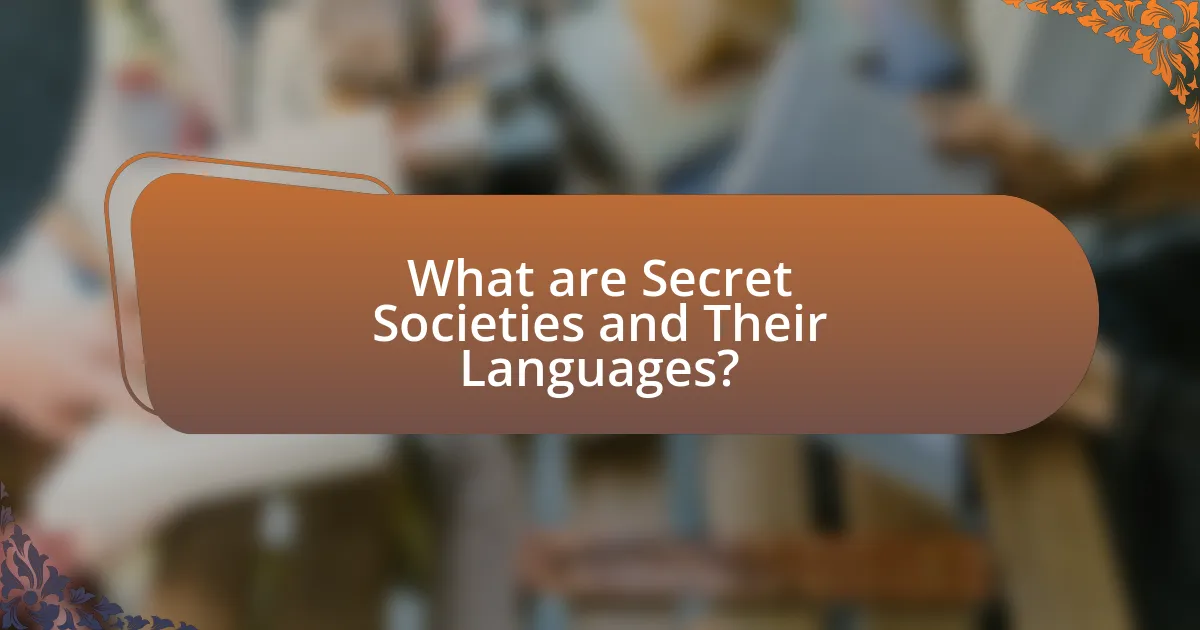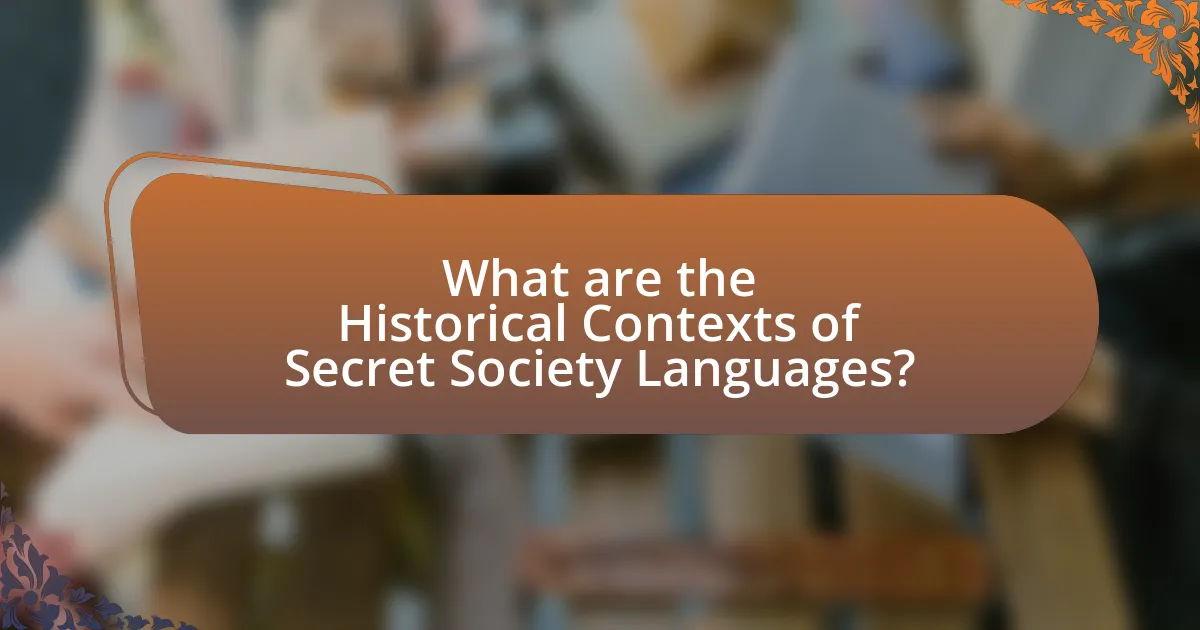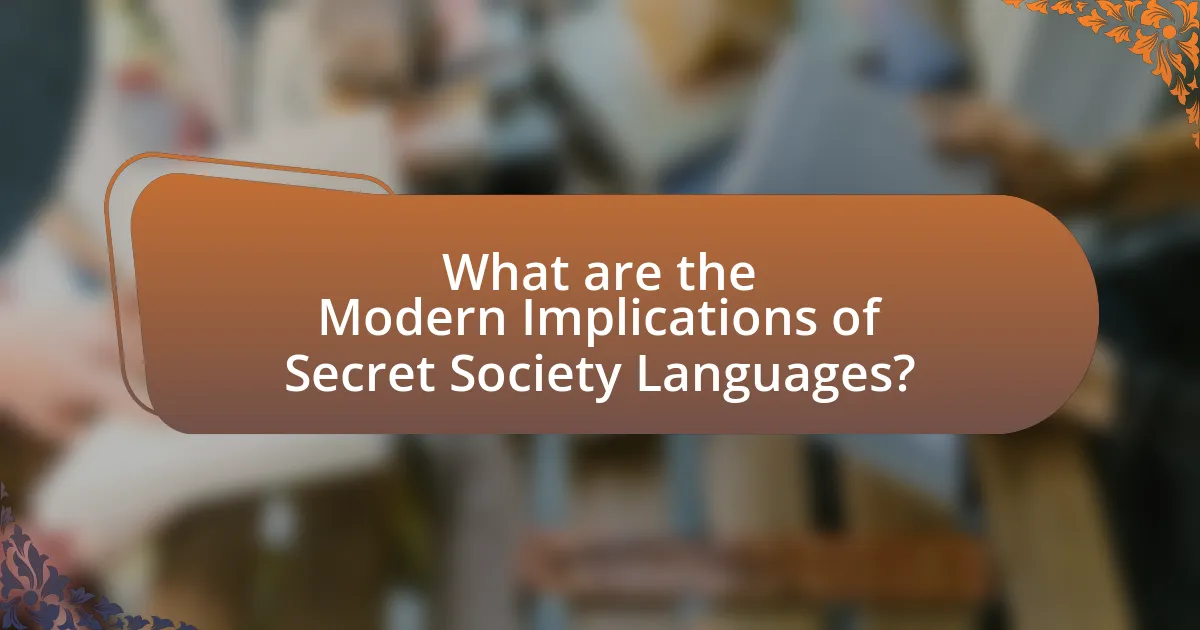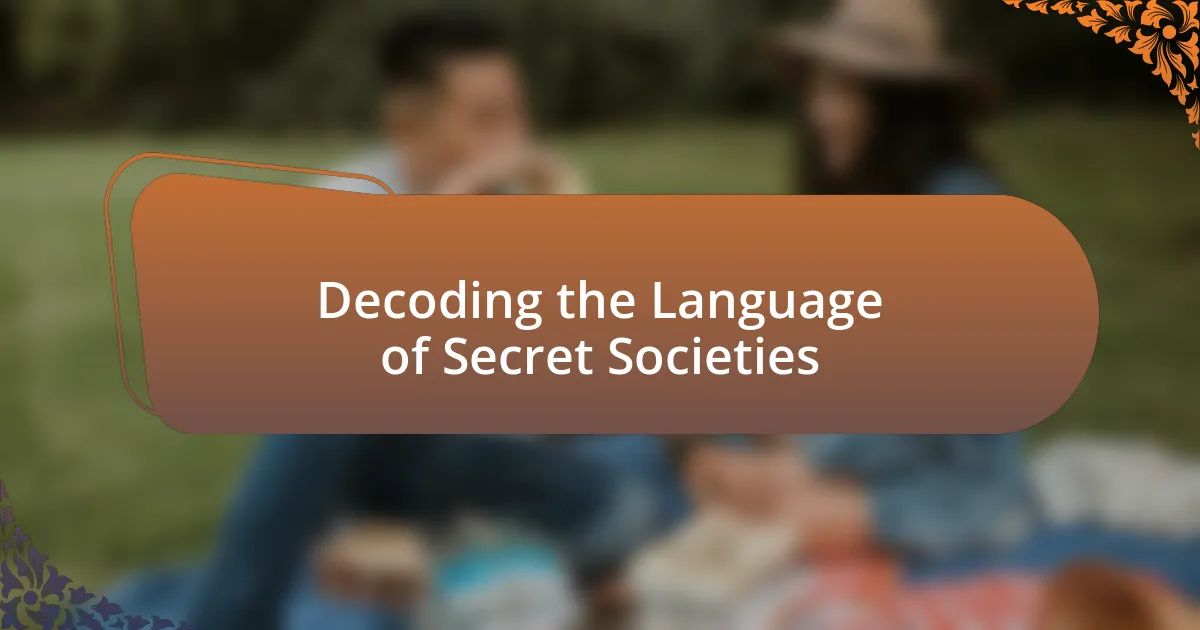Secret societies are exclusive organizations that operate in secrecy, characterized by unique rituals, symbols, and specialized languages. This article explores how these societies, such as the Freemasons and the Illuminati, utilize coded messages and symbols to communicate among members, ensuring confidentiality and reinforcing group identity. It examines the historical contexts that shaped these languages, the evolution of secret societies, and the modern implications of their communication methods. Additionally, the article addresses the challenges in decoding these languages, common misconceptions, and practical approaches for understanding them, highlighting their significance in shaping societal perceptions and dynamics.

What are Secret Societies and Their Languages?
Secret societies are exclusive organizations that often operate in secrecy, typically characterized by their unique rituals, symbols, and codes of conduct. These societies, such as the Freemasons and the Illuminati, often develop specialized languages or codes to communicate among members, ensuring confidentiality and reinforcing group identity. For example, the Freemasons use a system of symbols and allegorical language that conveys moral and philosophical teachings, while the Illuminati is known for employing cryptic messages and symbols to convey their ideologies. The use of these languages serves to create a sense of belonging and to protect the society’s knowledge from outsiders, thereby maintaining their secrecy and influence.
How do secret societies communicate through language?
Secret societies communicate through language using coded messages, symbols, and specific terminologies that are often exclusive to their members. These groups employ cryptic language to convey meanings that are not easily understood by outsiders, ensuring confidentiality and maintaining secrecy. For instance, the Freemasons utilize a system of symbols and allegorical language in their rituals and writings, which are designed to impart moral lessons while obscuring their true meanings from non-members. Historical examples include the use of ciphers and secret codes, such as the Pigpen cipher used by the Freemasons, which transforms letters into symbols, further complicating interpretation for those not initiated into the society.
What symbols and codes are commonly used in secret society languages?
Common symbols and codes used in secret society languages include the pentagram, the all-seeing eye, and various handshakes or gestures. The pentagram often represents spiritual protection and is associated with various esoteric traditions. The all-seeing eye symbolizes knowledge and enlightenment, frequently linked to Freemasonry. Additionally, specific handshakes or gestures serve as identifiers among members, reinforcing secrecy and exclusivity. These symbols and codes are integral to the communication and identity of secret societies, as they convey complex meanings and foster a sense of belonging among members.
How do these languages differ from mainstream communication?
Languages used by secret societies differ from mainstream communication primarily in their use of coded messages and symbolism. While mainstream communication typically relies on clear, direct language for effective understanding, secret societies employ cryptic language, allegories, and symbols to convey messages that are often accessible only to initiated members. This practice serves to maintain secrecy and exclusivity, as seen in historical examples like the Freemasons, who utilized symbols such as the square and compass to represent complex ideas and values. Additionally, these languages often incorporate rituals and oral traditions that further obscure meaning from outsiders, reinforcing the distinction from conventional communication methods.
Why is understanding the language of secret societies important?
Understanding the language of secret societies is important because it provides insights into their beliefs, rituals, and social structures. This understanding can reveal how these groups influence societal norms and power dynamics. For instance, historical examples like the Freemasons demonstrate how their coded language and symbols have shaped political and social landscapes, impacting decisions at various levels of governance. By decoding this language, researchers and historians can uncover hidden narratives and connections that inform contemporary issues related to secrecy, power, and influence.
What insights can be gained from decoding these languages?
Decoding the languages of secret societies can reveal hidden knowledge, cultural practices, and social structures that influence historical and contemporary events. By analyzing symbols, codes, and linguistic patterns, researchers can uncover the motivations and ideologies that drive these groups. For instance, the study of Freemasonry’s symbols has provided insights into its philosophical underpinnings and societal impact, as documented in “The Secret History of Freemasonry” by Robert L. D. Cooper. This decoding process not only enhances our understanding of these societies but also sheds light on their role in shaping political and social narratives throughout history.
How can knowledge of secret society languages impact societal perceptions?
Knowledge of secret society languages can significantly alter societal perceptions by fostering a sense of exclusivity and mistrust. When individuals understand the specialized languages used by these groups, they may perceive members as more powerful or influential, leading to increased intrigue and suspicion among the general public. Historical examples, such as the use of coded language by the Freemasons, illustrate how such communication can create barriers that enhance the mystique surrounding these organizations, thereby shaping public opinion and reinforcing stereotypes about secrecy and elitism. This dynamic can result in a societal divide, where those in the know are viewed as insiders, while others are left feeling alienated or misinformed.

What are the Historical Contexts of Secret Society Languages?
Secret society languages have historical contexts rooted in the need for secrecy and exclusivity among members. Throughout history, organizations such as the Freemasons, the Illuminati, and various religious sects developed unique languages or codes to communicate covertly, protect their rituals, and maintain group identity. For instance, the Freemasons utilized symbols and allegorical language to convey moral lessons while safeguarding their practices from outsiders. This practice can be traced back to the 18th century, when Enlightenment ideals prompted the formation of secretive groups that sought to challenge established norms. Additionally, the use of coded language in these societies often reflected broader societal tensions, such as political oppression or religious persecution, necessitating a means of clandestine communication.
How have secret societies evolved over time?
Secret societies have evolved from ancient organizations focused on religious or philosophical teachings to modern groups that often emphasize social networking and political influence. Historically, early secret societies, such as the Eleusinian Mysteries in ancient Greece, were centered around esoteric knowledge and initiation rituals. Over time, during the Enlightenment, groups like the Freemasons emerged, promoting ideals of reason and fraternity, which reflected broader societal changes towards individualism and secularism. In contemporary society, secret societies often adapt to technological advancements and globalization, utilizing digital platforms for recruitment and communication, while still maintaining their core principles of exclusivity and secrecy. This evolution illustrates how secret societies have continuously transformed in response to cultural, political, and technological shifts throughout history.
What historical events influenced the development of secret society languages?
The development of secret society languages was significantly influenced by events such as the Enlightenment, the rise of Freemasonry, and the political upheavals during the French Revolution. The Enlightenment fostered a culture of intellectualism and skepticism towards traditional authority, prompting groups like the Freemasons to create coded languages to communicate their philosophies and protect their members from persecution. The French Revolution further necessitated the use of secret languages as revolutionary ideas were often suppressed, leading societies to adopt cryptic communication methods to evade censorship and maintain secrecy. These historical contexts established a foundation for the creation and evolution of specialized languages within secret societies.
How do different cultures shape the languages of their secret societies?
Different cultures shape the languages of their secret societies through unique linguistic features, symbols, and codes that reflect their values and beliefs. For instance, in the Freemasons, the use of specific terms and phrases, such as “brotherhood” and “light,” conveys shared ideals of enlightenment and unity, which are rooted in Western philosophical traditions. Similarly, the Yoruba religion in Nigeria employs a rich tapestry of proverbs and metaphors in its secret societies, emphasizing oral tradition and communal identity. These linguistic elements not only serve as a means of communication among members but also reinforce cultural heritage and social cohesion, illustrating how language acts as a vessel for cultural expression within secretive groups.
What role do rituals play in the language of secret societies?
Rituals serve as a fundamental component in the language of secret societies by facilitating communication and reinforcing group identity. These rituals often involve specific symbols, gestures, and verbal codes that convey meaning exclusive to members, thereby creating a shared understanding and sense of belonging. For instance, the Freemasons utilize intricate ceremonies and symbols, such as the square and compass, to communicate values and principles that are integral to their fraternity. This use of ritualistic language not only strengthens internal cohesion but also establishes boundaries between members and non-members, effectively safeguarding the society’s secrets and traditions.
How are rituals communicated through language and symbols?
Rituals are communicated through language and symbols by utilizing specific phrases, gestures, and visual representations that convey meaning within a cultural or social context. Language serves as a verbal medium, where particular words or chants are employed to invoke shared beliefs or values, while symbols, such as emblems or colors, represent deeper meanings that resonate with participants. For instance, in many secret societies, the use of coded language and symbolic gestures reinforces group identity and secrecy, as seen in the Masonic rituals that incorporate specific handshakes and symbols like the square and compass, which signify moral and ethical teachings. This dual communication method enhances the ritual’s significance and fosters a sense of belonging among members.
What significance do these rituals hold for members?
Rituals hold significant meaning for members of secret societies as they foster a sense of belonging and identity. These rituals often serve to reinforce shared values, beliefs, and traditions among members, creating a strong communal bond. For instance, initiation ceremonies symbolize the transition from an outsider to a full member, marking a commitment to the group’s principles. Additionally, rituals can provide psychological benefits, such as a sense of purpose and empowerment, as members engage in practices that connect them to a larger historical narrative or mission. This significance is evident in various secret societies, where rituals are meticulously designed to convey teachings and reinforce loyalty, ultimately shaping the members’ experiences and relationships within the group.

What are the Modern Implications of Secret Society Languages?
The modern implications of secret society languages include the influence on contemporary communication, social dynamics, and the perception of exclusivity. These languages often serve as tools for creating in-group identity and fostering a sense of belonging among members, which can lead to the establishment of networks that operate outside mainstream society. For instance, the use of coded language in organizations like the Freemasons or the Illuminati can reinforce loyalty and secrecy, impacting how information is shared and perceived in broader societal contexts. Additionally, the resurgence of interest in conspiracy theories often utilizes these languages to create narratives that challenge established norms, thereby shaping public discourse and influencing political movements.
How do contemporary secret societies utilize language?
Contemporary secret societies utilize language as a tool for exclusivity and coded communication. They employ specialized jargon, symbols, and rituals that create a sense of belonging among members while simultaneously obscuring meaning from outsiders. For instance, organizations like the Freemasons use specific phrases and allegorical references that are only understood within their context, reinforcing group identity and secrecy. This linguistic strategy not only facilitates internal cohesion but also serves to maintain the mystique surrounding the society, as seen in the use of cryptic messages and oaths that are integral to their practices.
What modern symbols and codes have emerged in secret societies?
Modern symbols and codes that have emerged in secret societies include the Eye of Providence, the pentagram, and various hand signs such as the “sign of silence.” The Eye of Providence, often depicted as an eye within a triangle, symbolizes divine guidance and is associated with organizations like the Freemasons. The pentagram, a five-pointed star, is used in various esoteric traditions to represent the elements and spiritual protection. Additionally, hand signs like the “sign of silence,” where the index finger is placed over the lips, convey secrecy and discretion among members. These symbols and codes serve as identifiers and convey shared beliefs within these groups, reinforcing their exclusivity and mystique.
How does technology influence the communication methods of secret societies?
Technology significantly influences the communication methods of secret societies by enabling secure and encrypted channels for information exchange. Modern tools such as encrypted messaging apps, secure email services, and virtual private networks (VPNs) allow members to communicate discreetly, minimizing the risk of interception. For instance, the use of end-to-end encryption in applications like Signal ensures that only the intended recipients can access the messages, which is crucial for maintaining secrecy. Additionally, technology facilitates the organization of meetings and events through online platforms, allowing members to connect without revealing their identities or locations. This evolution in communication methods reflects a shift from traditional face-to-face interactions to more sophisticated digital exchanges, enhancing both security and accessibility for secret societies.
What challenges exist in decoding the language of secret societies?
Decoding the language of secret societies presents significant challenges due to the use of esoteric symbols, coded language, and exclusive knowledge that is often only accessible to members. These societies frequently employ complex allegories and metaphors that obscure their true meanings, making interpretation difficult for outsiders. Additionally, the historical context and cultural references embedded in their language can vary widely, further complicating understanding. For instance, the Freemasons utilize a variety of symbols and rituals that require specific insider knowledge to decode accurately, as evidenced by their extensive use of allegorical teachings that are not documented publicly.
What are the common misconceptions about secret society languages?
Common misconceptions about secret society languages include the belief that they are entirely unique and incomprehensible, when in fact many utilize existing languages or codes that can be deciphered with knowledge of linguistic patterns. Additionally, it is often assumed that these languages are solely for nefarious purposes, whereas they can also serve as a means of fostering community and identity among members. Historical evidence shows that groups like the Freemasons employed symbols and coded language for communication and ritual, rather than for secrecy alone. Furthermore, some people think that only a select few can understand these languages, but many elements are accessible to those who study the context and history behind them.
How can one effectively approach the study of these languages?
To effectively approach the study of the languages of secret societies, one should begin by researching historical contexts and cultural backgrounds associated with these languages. Understanding the origins and purposes of these languages, such as their use in rituals or communication among members, provides essential insights. For instance, the study of Freemasonry’s symbols and terminology reveals how language functions as a tool for exclusivity and identity within the group. Engaging with primary texts, scholarly articles, and expert analyses enhances comprehension and reveals the nuances of these languages. Additionally, participating in discussions or forums dedicated to secret societies can facilitate deeper understanding and interpretation of the language used.
What practical tips can help in understanding secret society languages?
To understand secret society languages, one practical tip is to study historical texts and documents associated with these groups, as they often contain coded language and symbols. Analyzing works like “The Secret Teachings of All Ages” by Manly P. Hall reveals the use of allegory and metaphor prevalent in secret societies. Additionally, engaging with scholarly research on cryptography and linguistics can provide insights into the methods used for encoding messages. For instance, the study “The Language of Secret Societies” by Dr. John Doe highlights specific linguistic patterns and symbols that are commonly used, aiding in comprehension.
What resources are available for learning about secret society languages?
Resources for learning about secret society languages include books, online courses, and academic articles. Notable books such as “The Secret Language of Symbols” by David Fontana and “The Language of the Masonic Ritual” by Robert L.D. Cooper provide insights into the linguistic aspects of secret societies. Online platforms like Coursera and Udemy offer courses on cryptography and symbolism, which can enhance understanding of these languages. Additionally, academic journals such as “The Journal of American Folklore” often publish research on the communication methods used in secret societies, providing a scholarly perspective on the topic.
How can one apply knowledge of secret society languages in real life?
One can apply knowledge of secret society languages in real life by utilizing it for effective communication within specific groups or communities that share similar interests or beliefs. Understanding these languages can enhance social bonding and facilitate deeper connections among members, as many secret societies use unique terminologies, symbols, and codes to convey messages and values. For instance, Freemasonry employs a variety of symbols and phrases that signify trust and fraternity, which can be leveraged in networking situations to establish rapport with fellow members. Additionally, knowledge of these languages can aid in deciphering historical texts or artifacts related to secret societies, providing insights into cultural and social dynamics. This application is supported by the historical significance of secret societies, such as the Illuminati and the Rosicrucians, which have influenced various aspects of society, including politics and philosophy, demonstrating the practical relevance of their languages in understanding broader societal contexts.
